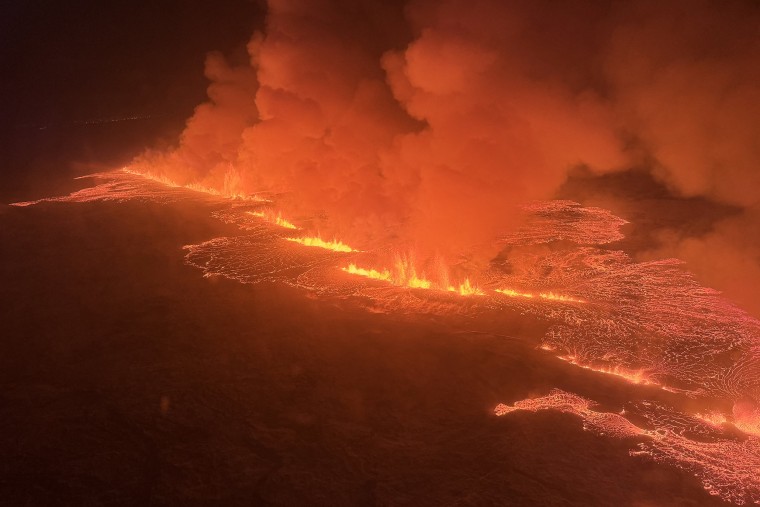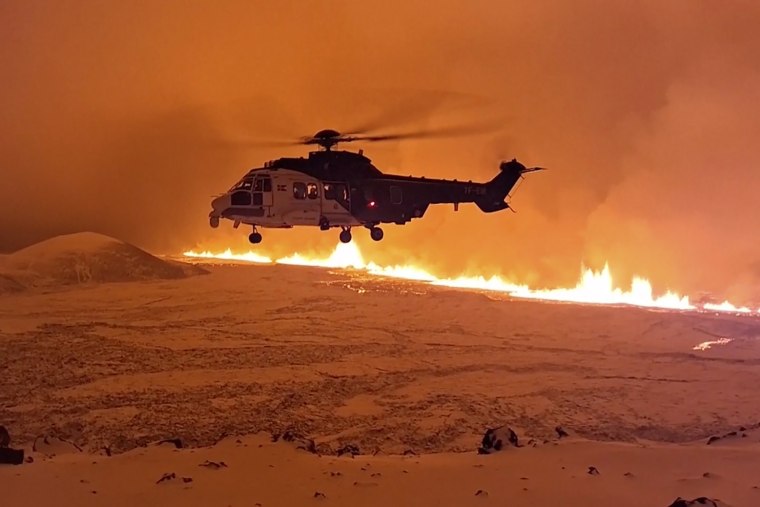REYKJAVIK, Iceland — A volcanic eruption lit up the sky over Iceland on Monday night, creating a 2½ mile fissure that sent a river of lava flowing toward surrounding towns and threw molten rock 300 feet into the air.
Police declared a state of emergency and tourists spots were closed as hundreds of cubic meters (thousands of cubic feet) of lava spewed across the Reykjanes Peninsula. The eruption took place in the southwestern part of the island, near the Keflavik International Airport, the capital city of Reykjavik and country's famous thermal springs.
The long-expected eruption was finally recorded at 10:17 p.m. (5:17 p.m. ET), according to the Icelandic Meteorological Office, which has closely monitored seismic activity in the area for weeks.
The lava flow has slowed since its peak late Monday night, with lava fountains falling from 300 feet to 100 feet, but authorities remain on high alert and evacuated areas remain off limits.
The eruption is now about one-quarter its size at the start of the eruption and a third of the original fissure is active as of Tuesday afternoon local time, according to the Icelandic Met Office.
The majority of the lava flow is heading east towards Fagradalsfjall, and two streams are reaching west, north of Stóra-Skógfell. The volcanic plume is now moving from the west and northwest, and gas pollution may be noticeable in Vestmannaeyjar and may be detected in the capital area late Tuesday night or Wednesday morning.
Lovísa Mjöll Guðmundsdóttir, a natural hazard expert at the meteorological office, said that more cracks in the earth are possible.
Guðmundsdóttir noted that at the north end of the fissure, lava is moving towards the Grindavík road and has already flowed about 40% of the way to the road.
"According to our data as of now, it will take the lava considerable amount of time to reach the road, if that happens — it's difficult to evaluate. All in all, the flow of the lava is moving in a favorable direction if we keep in mind all infrastructure in this area, Grindavík town and Svartsengi power plant for example," she said.
It's positive news for the more than 3,400 people of the small fishing town of Grindavík, 1.8 miles from the southern end of the fissure. Residents were evacuated in November after it was hit by earthquakes and large cracks emitting plumes of steam appeared in roads.
More than 100 families from Grindavík are in urgent need of housing until at least January, Mayor Fannar Jónasson told the Icelandic public broadcaster RUV.
"Unfortunately, there are far too many families who are not doing well enough in that respect," he said.
Grindavík resident Siggeir F. Ævarsson, a 38-year-old teacher, expressed relief at the eruption after the month-long "emotional rollercoaster."
“Only yesterday, the police said that it would be possible for us to go back for Christmas, so many got their hopes up high,” Ævarsson said. Hours later, the fissures cracked and roared with lava.
“It's also a relief after a long period of uncertainty since me and my family moved from Grindavík the 10th of November after constant, eternal earthquakes, more than I've ever witnessed. After it started erupting, we've come closer to the end of this episode,” he said.
Prime Minister Katrín Jakobsdóttir said Tuesday that she was grateful the evacuation was still in effect in Grindavík last night when news of the eruption arrived.
"Naturally, there was a certain impatience among the residents to be allowed to return home, as the evacuation has been going on for a long time," she said, adding that while the lava flow was currently not a threat to settlements, this could change.
The U.S Embassy in Reykjavik advised Americans to avoid the area surrounding the eruption and monitor local media for information and guidance.

Webcams showing live images of the eruption showed white-hot bubbling pools of churning lava Tuesday morning.
"This eruption is more powerful than three former eruptions in that area and it happened unusually fast," Freysteinn Sigmundsson, a geophysicist at the University of Iceland, told NBC News. "Pressure was enough to break the crust rapidly.”
"The lava flow on the ground is still in a remote area, so at this point it's not an immediate threat to the town Grindavík or the power plant Svartsengi. But there can still be a risk of lava flow damaging infrastructure," he said.
The meteorological office said that there was "significant ground disruption" from the eruption, which could last as long as 10 days, but that the intensity of the eruption was already decreasing early Tuesday.
Iceland's civil defense coordination center has been activated as a precaution, and police raised the nation’s civil defense preparedness level, according to a statement from civil defense officials.
Authorities asked the public not to visit the area of the volcano.
While some nearby population centers have been evacuated, there have been fears that an eruption could send lava toward power plants, but experts said this was now unlikely.
"If everything is normal, this will subside in the afternoon tomorrow, the crack will begin to retreat into craters. The eruption could last a week to 10 days," Ármann Höskuldsson, a volcanologist, told RUV on Monday night.
However, others warned that the direction of the lava flow could quickly change.
Asked where the lava could flow early Tuesday, volcanologist Þorvaldur Þórðarson told RUV: "That's a good question — it could go close to major infrastructure in a relatively short period of time."

He said that defenses that had been built near the Svartsengi power plant and the Blue Lagoon, a popular spa destination currently closed to visitors, would "hopefully prove to be good for us," while adding that lava has been flowing up 0.6 mph.
The lava flow could move toward Reykjanesbraut, a major road running east to west along the peninsula, and the small village of Vogar, "so we have two urban areas that are in a certain danger," he said.
Keflavik Airport remains open for business, with flights arriving and leaving, but departure boards showed there were several delays. Monday’s eruption differs from the Eyjafjallajökull volcano eruptions in 2010, when hot magma met a glacier and sent hot ash miles into the sky, causing delays and cancellations for millions of air travelers.
Dave Steward, an American living in Iceland who runs tourism company Travel Shift, said “it's pretty much business as usual” on the ground.
“In my opinion this will present more of an attraction to Iceland. We've seen our bookings picking up in helicopter rides after the eruption started. To see an active volcano, to see mother nature in its awesome power, is an incredible experience,” he said. “I admire the attitude of Icelanders. Very resilient, tough, definitely not uptight, just accepting the weather and what mother nature brings.”
The meteorological office said it would monitor the situation and convene a meeting of scientists to evaluate the overnight developments. The Icelandic Cabinet is also due to meet Tuesday morning.
Björg Magnúsdóttir reported from Reykjavik, Iceland; Dennis Romero reported from Los Angeles; Patrick Smith reported from London.

